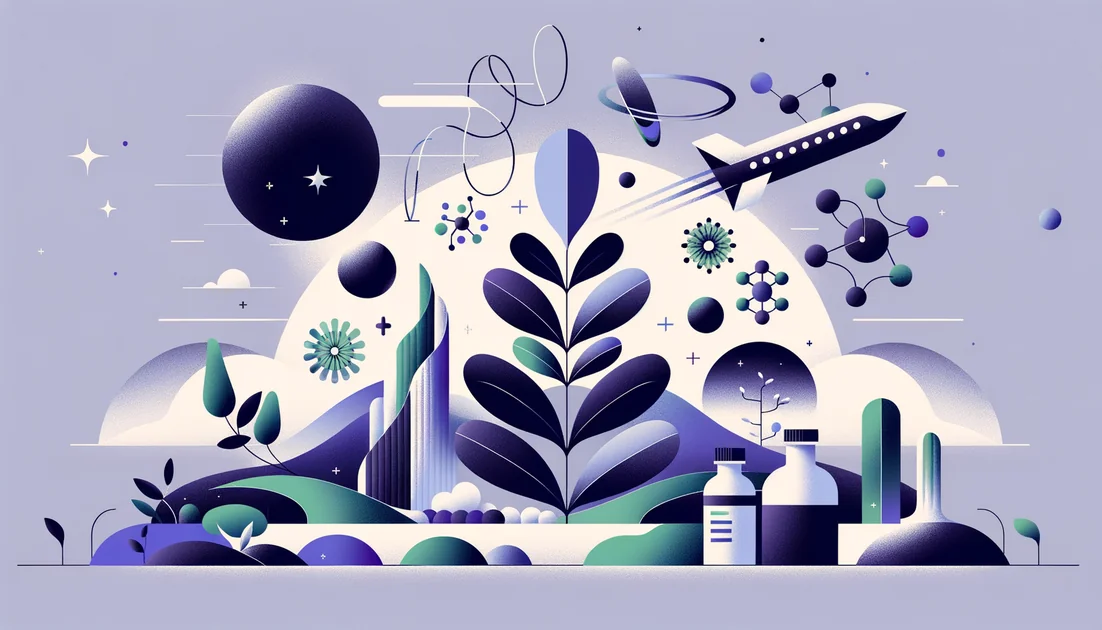
Smell of a Horse, Calm in a Storm: Ashwagandha's ancient promise meets modern stress
The first surprise is in the name. Ashwagandha literally means "smell of a horse," a nod to roots said to carry the animal's odor—and, in Ayurveda, its vigor. Yet this earthy plant is most famous today for something quieter: helping people sleep, steady their nerves, and endure daily stress. How did a herb named for horsepower become shorthand for calm? [1]
- Evidence
- Promising
- Immediate Effect
- No → 6–8 weeks
- Wears Off
- Unknown; likely gradual over weeks after stopping
From Sanskrit to subway
For more than two millennia, ashwagandha has lived in India's medical canon as a Rasayana—a class of rejuvenators meant to restore strength, resilience, and longevity. Classical texts place it alongside other tonics designed to steady a person through life's seasons, not just treat a single symptom. Think of Rasayana as an old operating system for human robustness, with ashwagandha as one of its core apps. [2][3] Modern guides echo the heritage while translating it for today's concerns: stress, sleep, fertility, and athletic performance. The U.S. National Institutes of Health summarizes the state of play plainly: some preparations may help with insomnia and stress, with mixed evidence for anxiety; long-term safety isn't well known. [1][2]
What the trials actually show
When researchers put ashwagandha under the bright lights of randomized trials, a pattern emerges: modest but meaningful relief over weeks. A 2024 meta-analysis of randomized controlled trials found significant improvements on standard stress and anxiety scales and reductions in cortisol—the body's "go" hormone that spikes under pressure. [3] Picture cortisol as the office fire alarm; ashwagandha seems to help reset the sensitivity so it doesn't blare at every burnt piece of toast. Another 2024 review focusing on anxiety and insomnia concluded that ashwagandha extracts improved several sleep measures—time to fall asleep, sleep efficiency, total sleep time—though studies were small and varied. [5] If you've ever watched a child's mobile gently slow, that's the feel of these data: motion settling, not forced stillness. Zoom in on individual trials and the story gains texture. In one double-blind, placebo-controlled study, adults with chronic stress took 300 mg of a standardized root extract twice daily. After 60 days, they reported lower perceived stress and showed lower cortisol than placebo. [6] Another trial in people with non-restorative sleep used a 120 mg extract daily and saw better sleep efficiency and shorter time to nod off over six weeks. [7] These aren't knockout sedatives; they read more like the body learning to coast again. Not every analysis is glowing. A 2022 dose-response meta-analysis reported benefits for stress and anxiety but graded the overall certainty as low, urging better, larger trials. [4] That humility matters: the herb's promise is real, but the measuring sticks need to be sturdier.
A quiet caution: the rare plot twists
Most people in studies tolerate ashwagandha for a few months with only mild complaints like drowsiness or stomach upset. But rare events remind us that "natural" is not a synonym for "risk-free." Regulators in Australia advised consumers in 2024 that products containing Withania somnifera may, in rare cases, injure the liver; those with current or past liver problems should avoid it. [8]
"If you currently have or have had liver problems, you should avoid..Withania somnifera," their notice states. [8] Case reports from several countries describe cholestatic or mixed-pattern liver injuries appearing weeks after people began supplements, with most resolving after stopping; a few required intensive care. [11][12][13] Separately, clinicians have documented rare episodes of thyrotoxicosis—an overactive thyroid—linked to use, which reversed after discontinuation. [9][10] These are outliers, but they shape wise use: if your liver or thyroid has a backstory, involve your clinician before starting.
The hidden variable: what's in the bottle?
In Ayurveda, the root is the star. In the modern marketplace, you'll find root-only, root-and-leaf blends, and sometimes unlabeled mixes. Why care? Leaves naturally have different withanolides—the plant's signature compounds—than roots, and undisclosed blending can skew potency and effects. In 2019, a quality-watchdog consortium warned about economic adulteration with undeclared leaf material. As American Botanical Council founder Mark Blumenthal put it, "The inappropriate and unethical practice of increasing the amount of withanolides..by adding undisclosed, lower-cost dry leaf material..has been confirmed." [14][15] Choose brands that disclose plant parts, standardization, and third-party testing.
How it likely works (in human terms)
Rather than "modulating pathways," think of ashwagandha as coaching two interlocking systems back into rhythm: the stress-response network that runs from brain to adrenal glands, and the sleep-wake circuitry that rewards consistent cues. Trials repeatedly show changes in feelings (lower perceived stress), hormones (often lower cortisol), and sleep architecture (more time asleep, less time staring at the ceiling). It's less a hammer and more a metronome. [3][5][6][7]
Putting it to work (without the hype)
For stress and sleep, many trials cluster around 300–600 mg/day of standardized root extract for 6–8 weeks, often with food and evening dosing if sleep is the target. [1][6][7]
Expect gradual benefits. Some feel calmer within a couple of weeks; most measurable changes show up by week 6–8. [5][6][7]
If you lift or run, small trials suggest potential gains in VO₂max, recovery, and strength over 8–12 weeks when paired with training—but this is a secondary lane, not the main road. [16][17]
Quality matters: look for root-only products unless a root-and-leaf blend is clearly labeled; insist on third-party testing (USP, NSF, Informed Choice). [14][15]
Stop and seek care if you notice dark urine, yellowing eyes/skin, severe itching, or unusual fatigue. [8]
"It's challenging to develop recommendations for using ashwagandha, because studies have used various preparations and doses." [1] That line from the NIH captures the present moment: encouraging signals, uneven methods. Let it guide your expectations—and your shopping.
What we still don't know
Three gaps loom: (1) long-term safety beyond a few months; (2) head-to-head comparisons between root-only and root-plus-leaf extracts; (3) clarity on who benefits most—stressed but otherwise healthy adults, people with insomnia, or specific subgroups. Until then, ashwagandha is best treated as a supportive instrument in the orchestra: helpful for harmony, not a soloist meant to drown out medical care. [1][2][4]
A closing thought
Ancient physicians designed Rasayana to help humans stay steady in an unsteady world. Today's studies hint that ashwagandha can still do that—dialing down the internal alarm and smoothing the edges of sleepless nights—provided we respect both its power and its limits. The root may smell like a horse, but the best outcomes arrive like a well-trained one: strong, steady, and responsive to the reins. [2][5][6]
Key takeaways
- •Rooted in Ayurveda as a Rasayana, ashwagandha is framed here as a resilience aid for sleep, stress, and steady energy—best used alongside lifestyle basics.
- •Evidence is promising: randomized trials report reduced perceived stress and cortisol and better sleep efficiency, total sleep time, and latency, with larger effects at higher doses and ≥8 weeks.
- •Practical dosing from trials commonly ranges 300–600 mg/day of standardized root extract; start low, reassess at 6–8 weeks, and avoid open-ended use without clinician input.
- •Timing matters: take in the evening with food for sleep support; split morning/evening for daytime calm—expect gradual changes, not a same-day knockout.
- •Cautions: stop and seek care for signs like dark urine, yellowing eyes/skin, severe itching, abdominal pain, or unusual fatigue; discuss use if on thyroid, sedative, immunosuppressant, or diabetes meds.
- •Philosophy: it's not a silver bullet—ashwagandha works best as part of a broader stress toolkit (sleep, movement, mindfulness).
You might also like
Explore more of our evidence-led investigations, comparisons, and guides across every article style.

Bluebonnet Nutrition (supplements)
The Paradox of Bluebonnet Nutrition: Certification Powerhouse, Modest Innovation, Limited Public COAs

L-Theanine vs GABA (gamma-aminobutyric acid)
For calm without sedation, choose L-theanine; it reliably shifts brain activity toward relaxed alertness and has better central access. GABA can feel calming for some but evidence is limited and it's more likely to sedate. [2][7][8]


Spirulina
In a bustling market five centuries ago, a soldier tasted green cakes that "taste like cheese." Today, astronauts sip green smoothies brewed from the same organism aboard the International Space Station. What happened in between—and what can spirulina actually do for you?

Calm Focus Unlocked: Kill The Jitters
Real but modest, short-term benefits with a "gas pedal + steering" effect; best for focused tasks, not all-day stimulation.

Tocotrienols
The stealthier cousins of vitamin E—built with springy tails that move differently in cell membranes and behave differently in your body.


